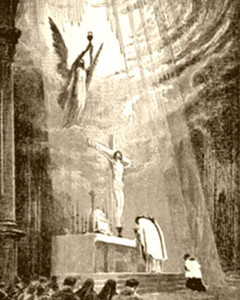Joseph Shaw, of the UK’s Latin Mass Society, builds off of my post on Shawshank Redemption and the Liturgy, in a post of his own, noting:
The blogger at ‘Shameless Popery’ says this tells us how important music is at Mass. Actually, it tells us much more than that. It tells us about the value of non-verbal participation.
‘Red’, the film narrator, doesn’t even want to know what the words meant. The music and the sound of the Italian were expressive in a way that a translation could not be; one might add that offering the listener the meaning of the words at the time would have distracted him from listening. I am a big opera fan, and I’m not against ‘surtitles’ at the opera on balance, but one must acknowledge their disadvantages: one can easily end up staring at the words instead of looking at the singers, attending to the English and not listening to the song. It is the same with using a hand missal at Mass: Missals are good things, but sometimes one wants to put the thing down and engage with the Mass wordlessly.
He then explains that while it’s important to know what’s going on at Mass,
Great works of art and the liturgy are not sponges, to be sucked dry, but wells, from which one may draw water every time one experiences them. To experience them fully, it is necessary at a certain point to stop analysing, take one’s nose of the book one is holding, and just let it sink in.
Beautifully said. Ideally, the Mass should be the fullest experience we can achieve of Truth, Goodness and Beauty. The more we understand it, the more Truth we can derive from the Mass, so accessibility is important. But we should be careful that we’re not upholding accessibility at the cost of all of the other goods, particularly the beauty of the Liturgy.

Amazing picture. Where did you find it?
Good question. It’s from Catholic Home and Garden, but honestly, I just found it from doing a Google Image search for “Latin Mass.” I’d seen it (or some variation) before, and just find it to be a beautiful image.